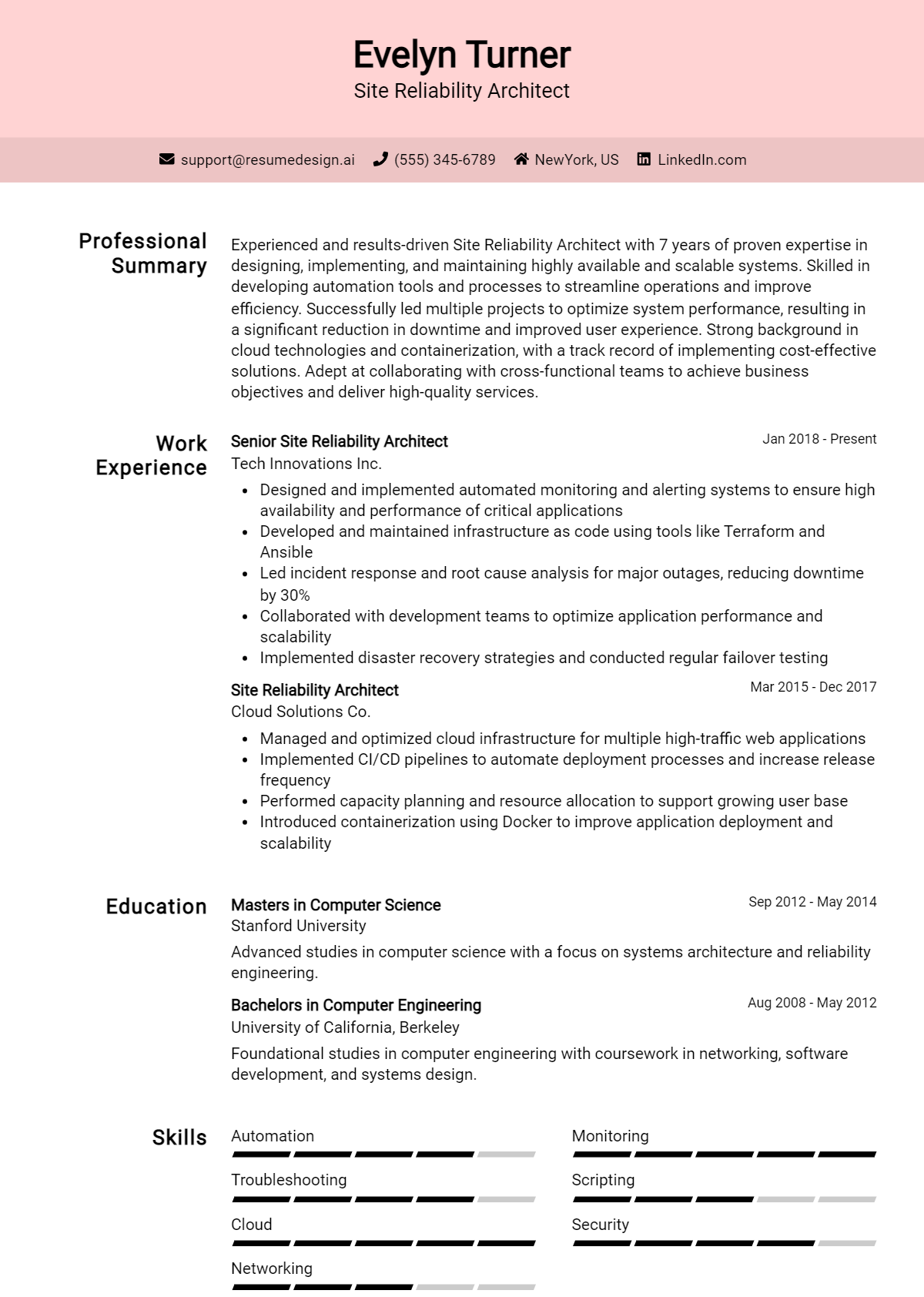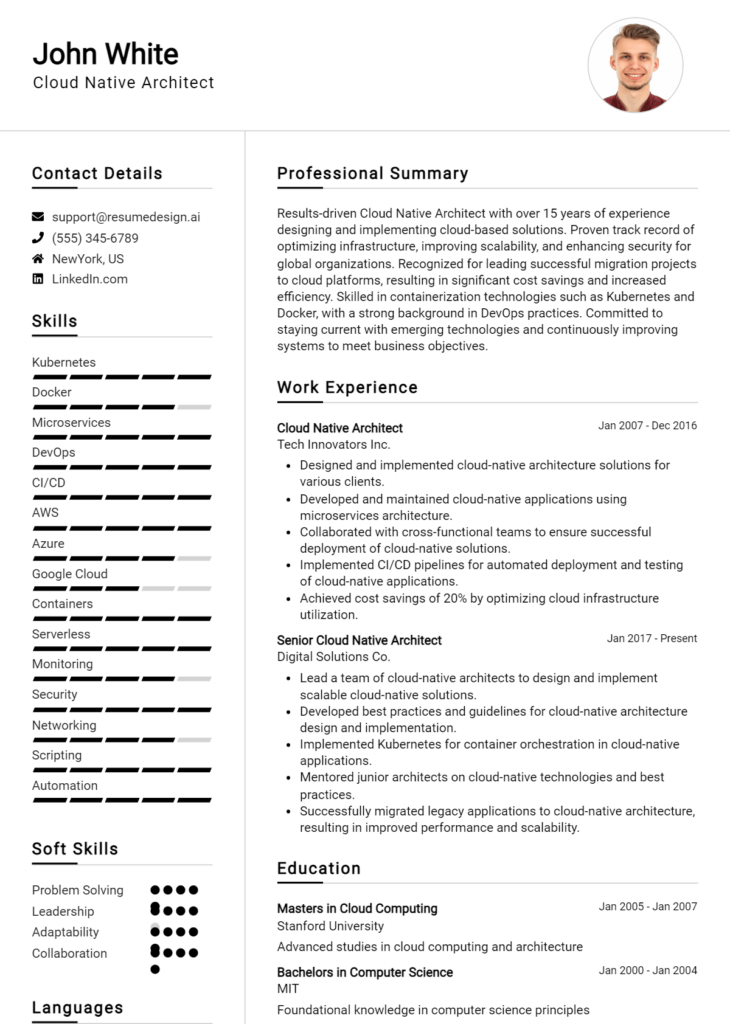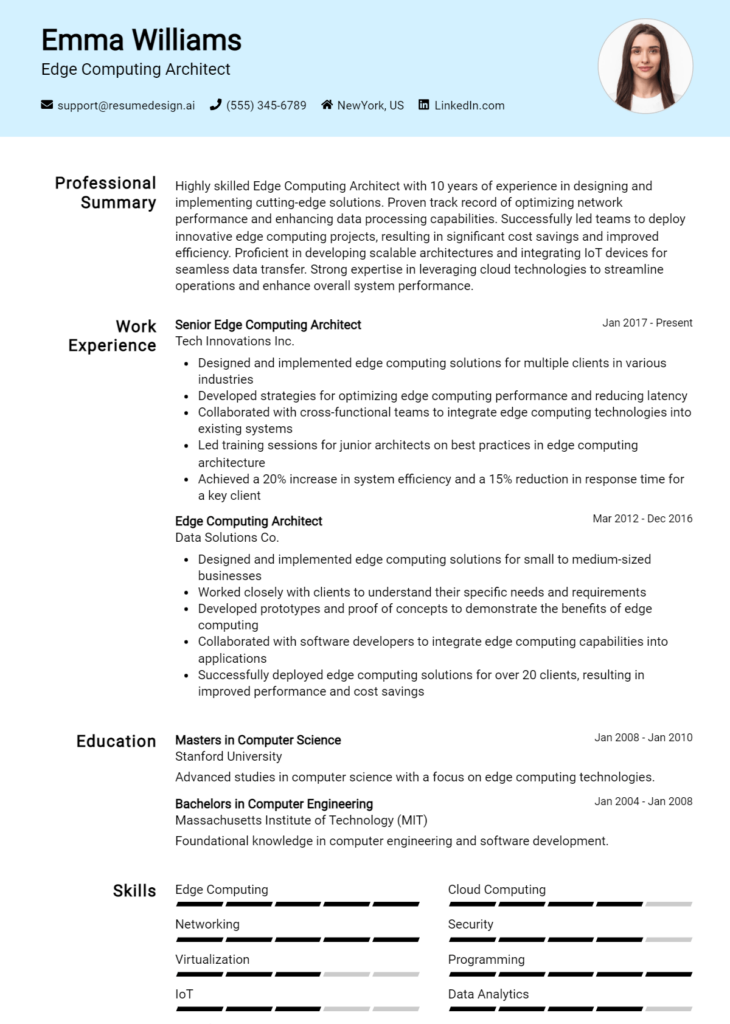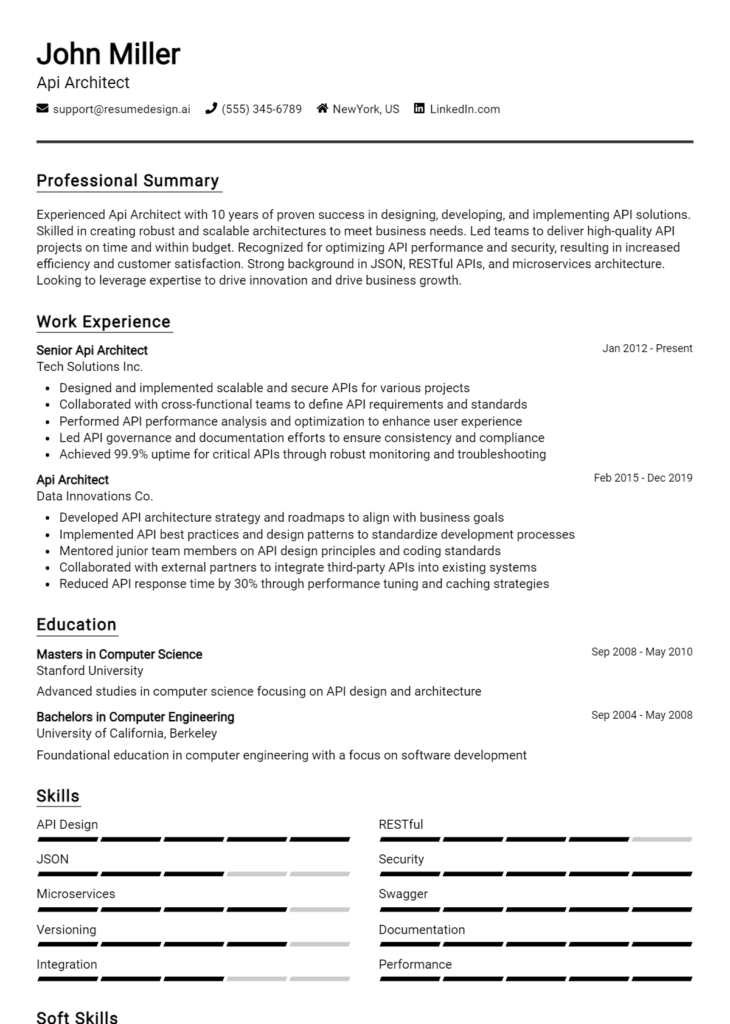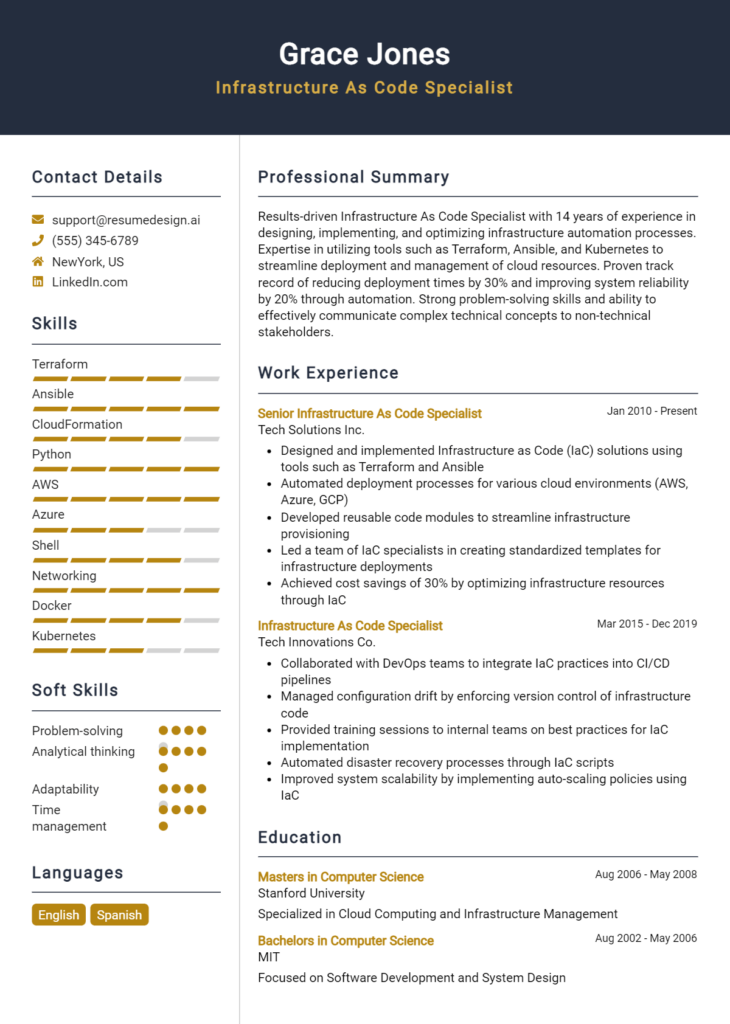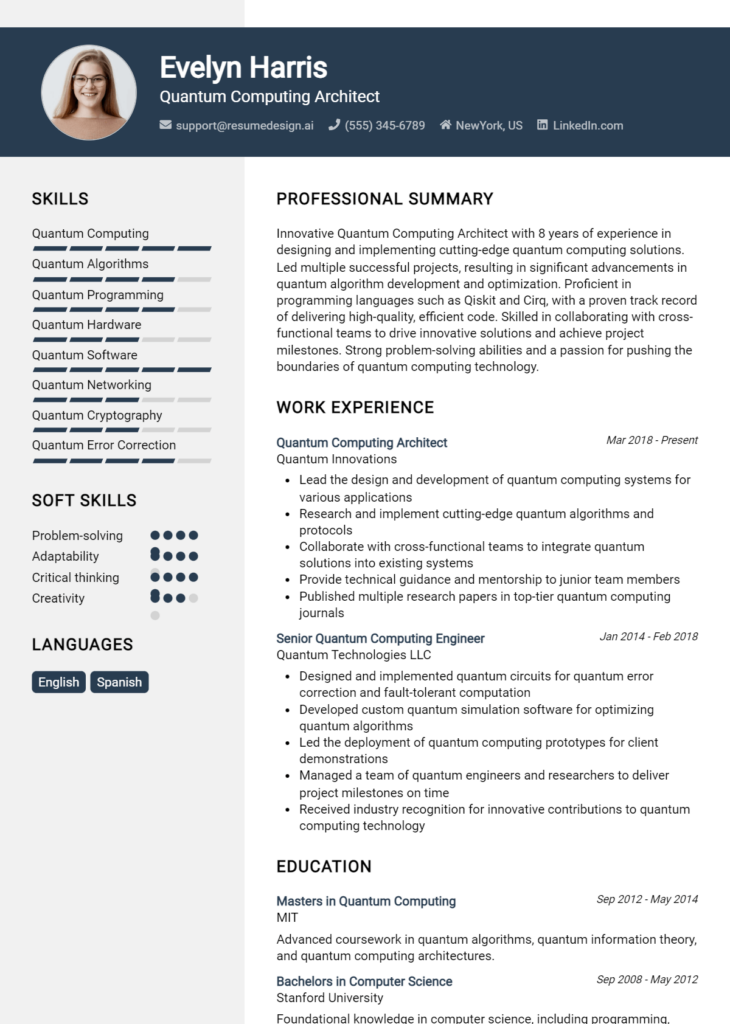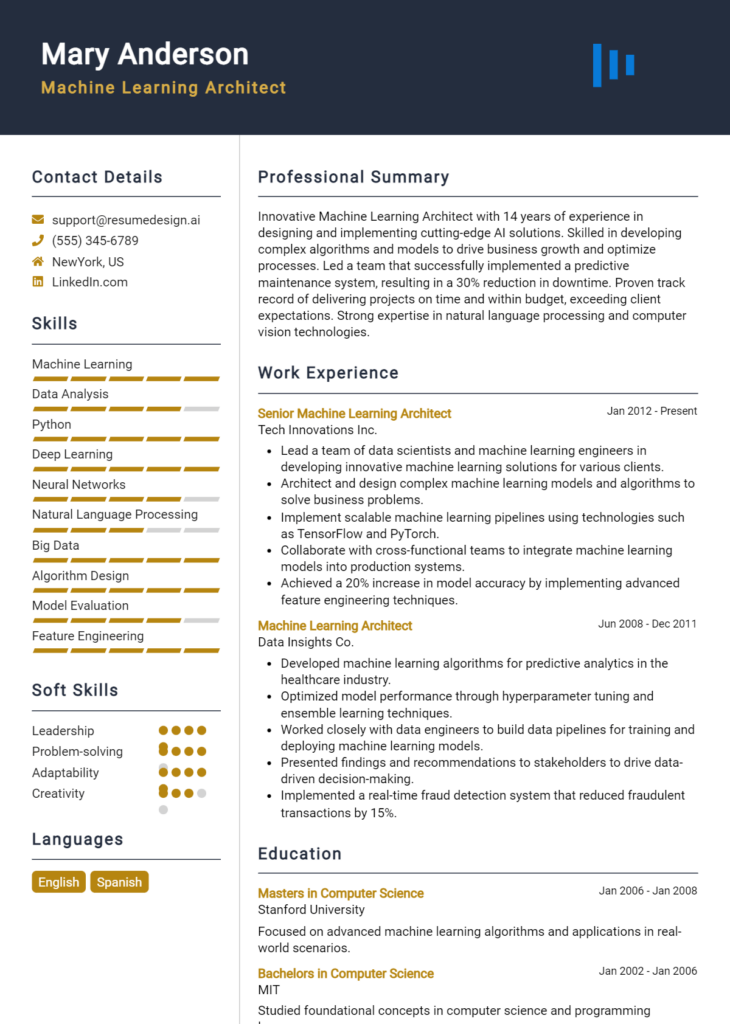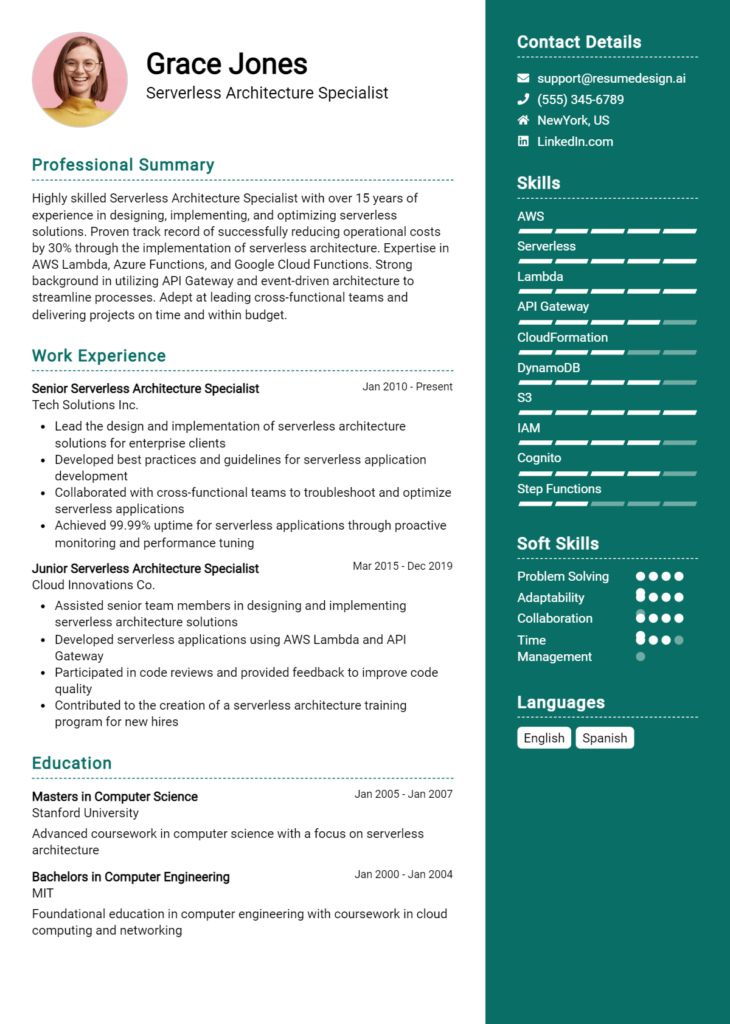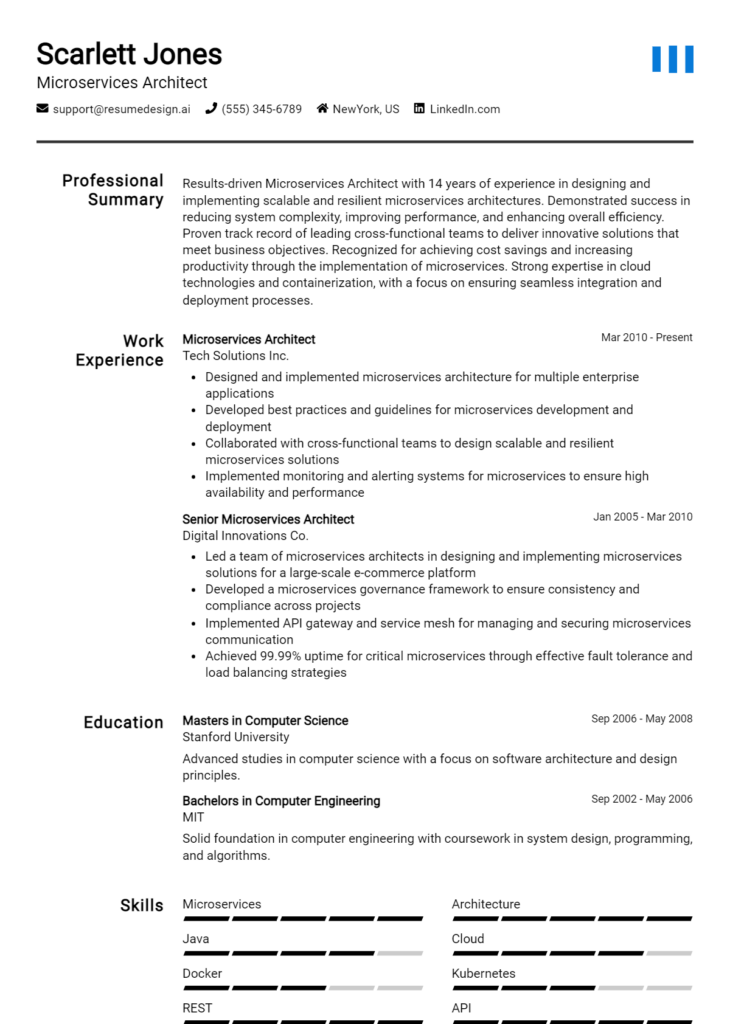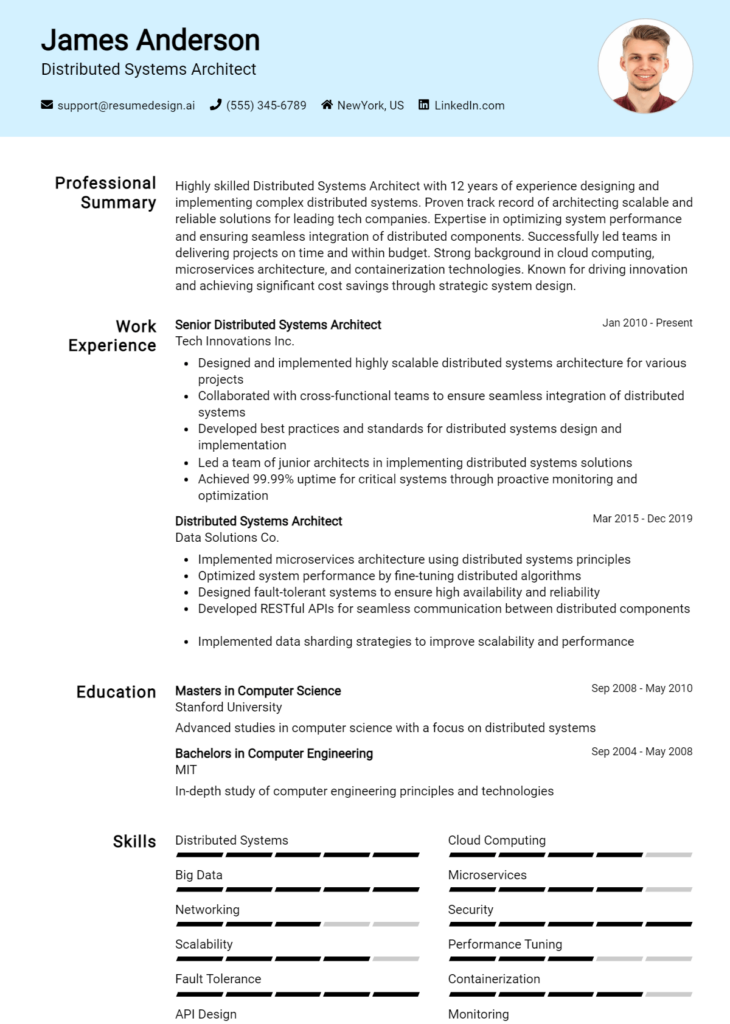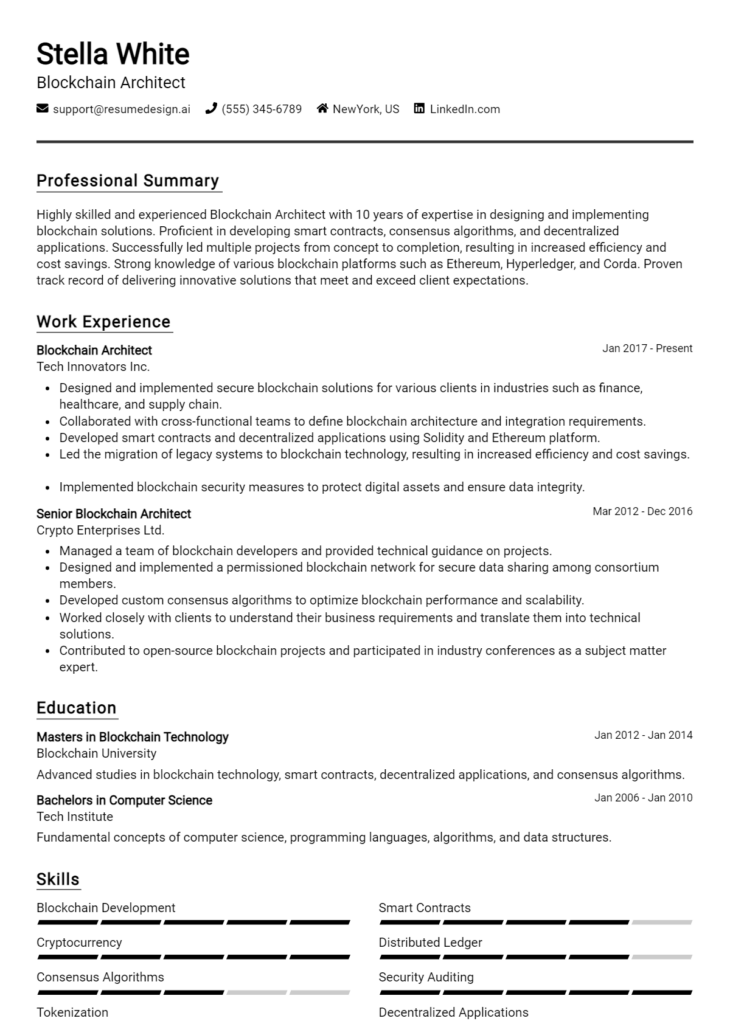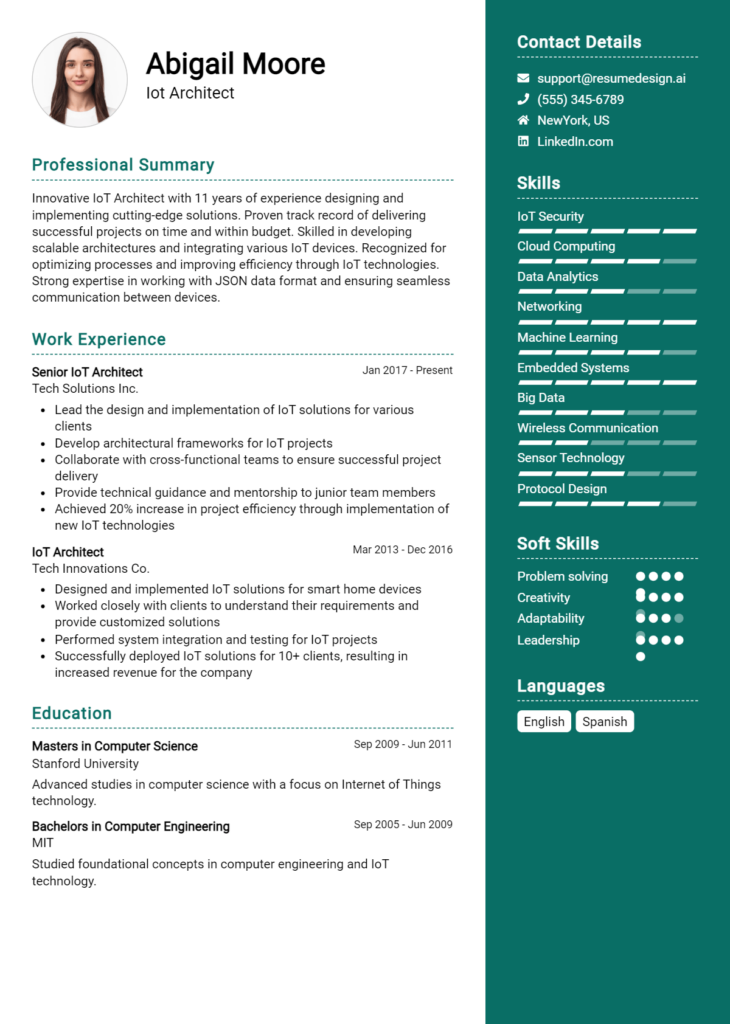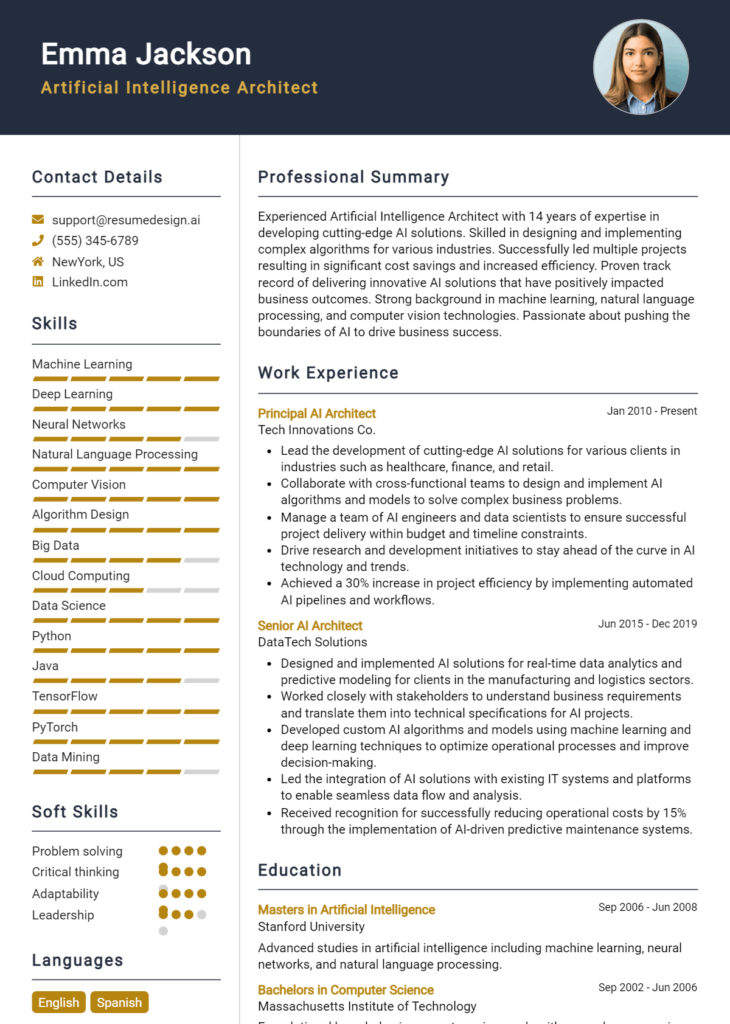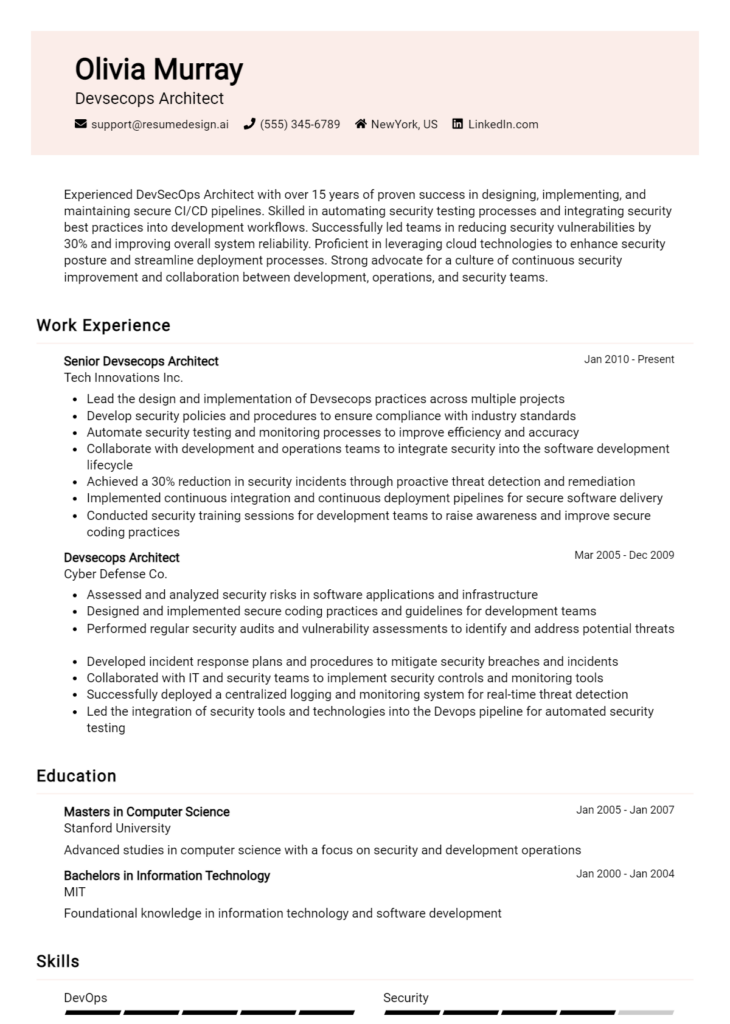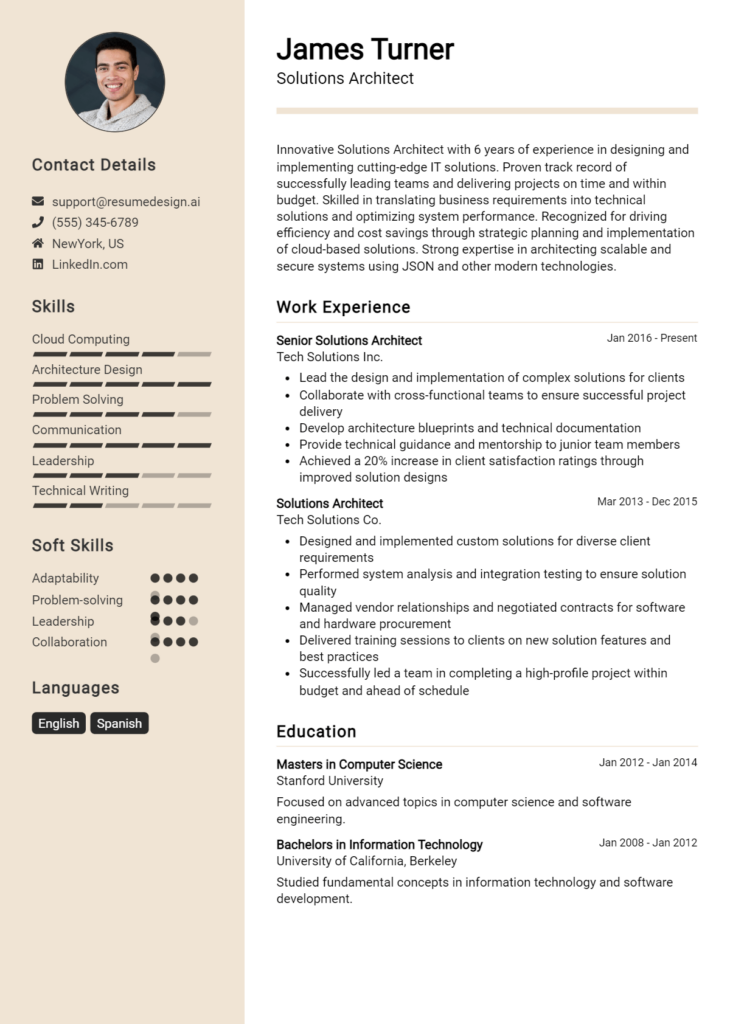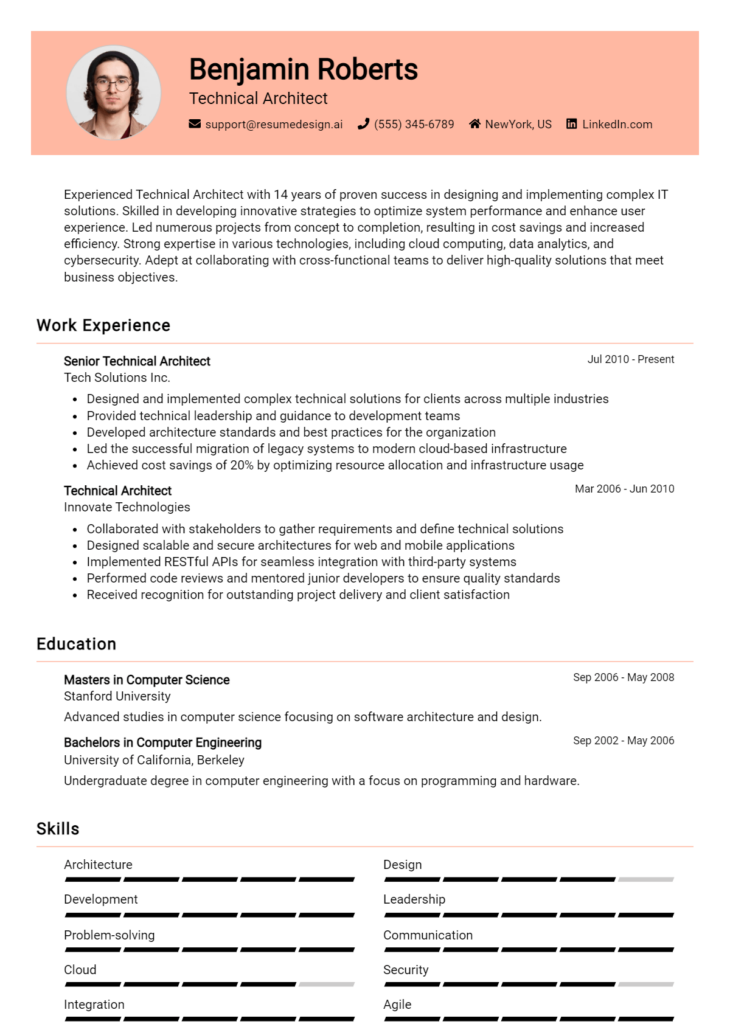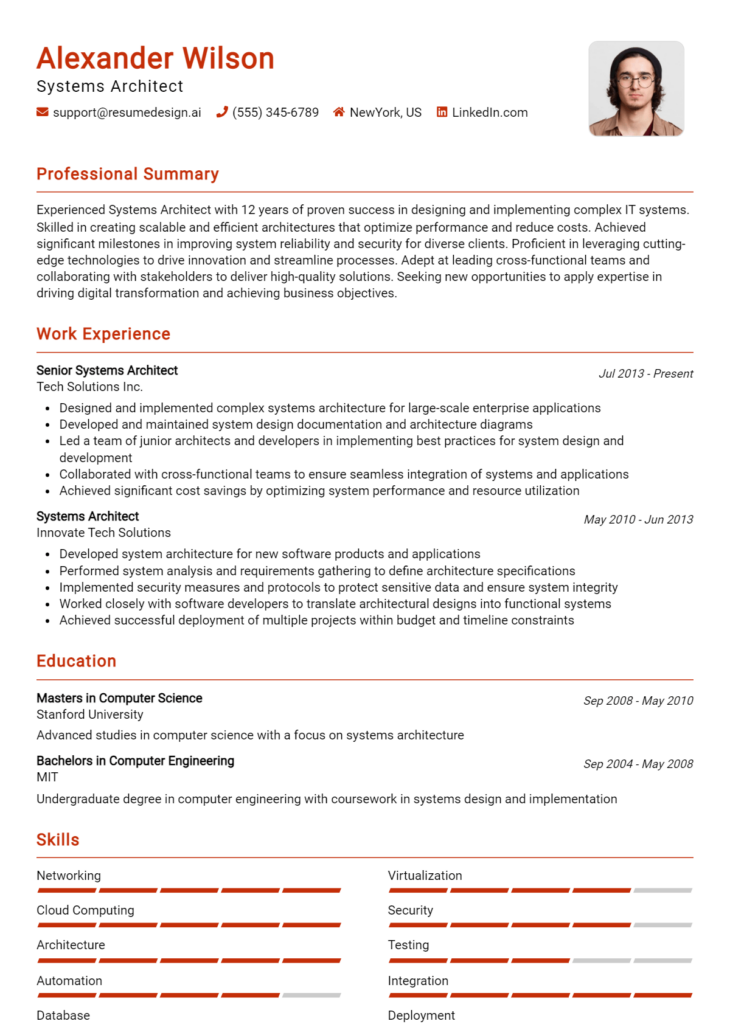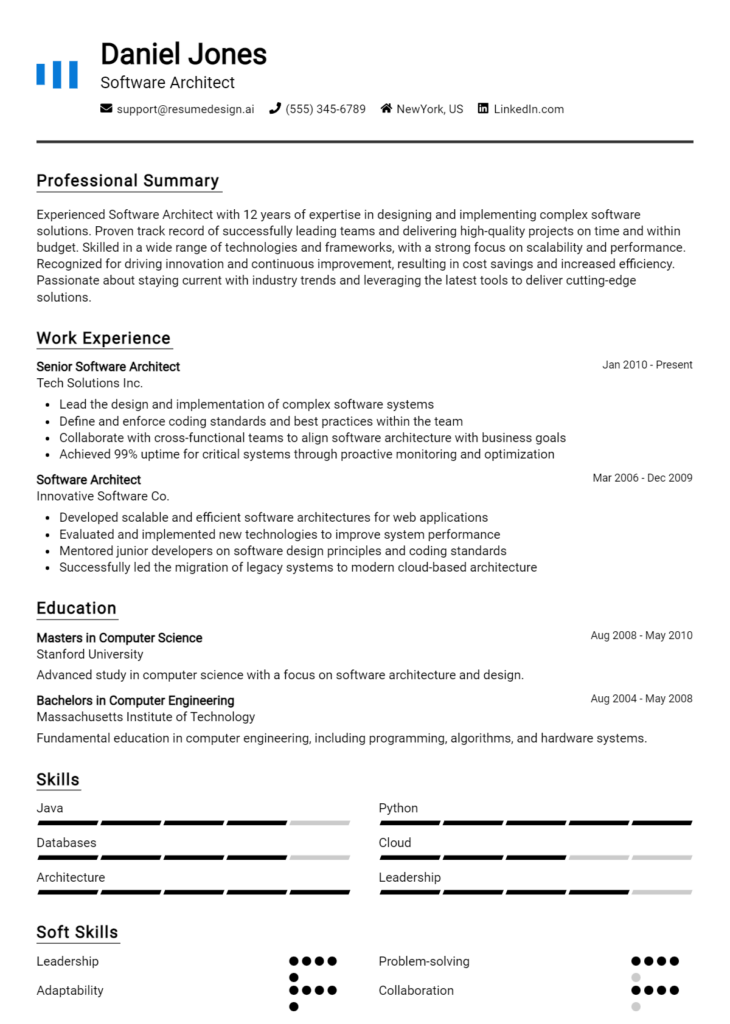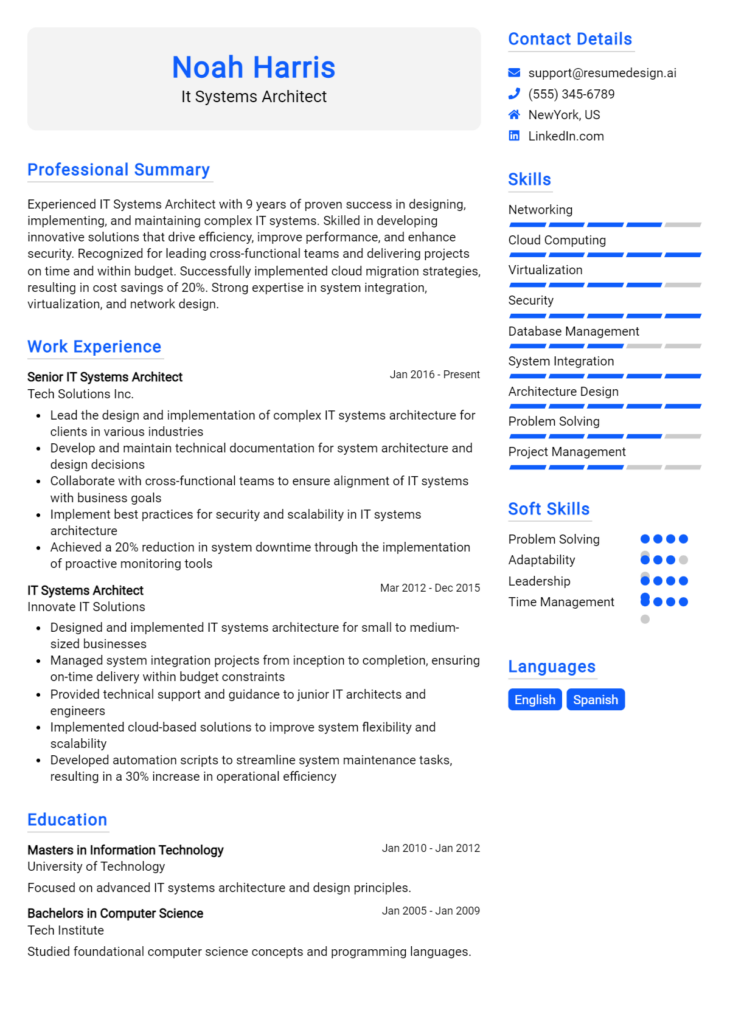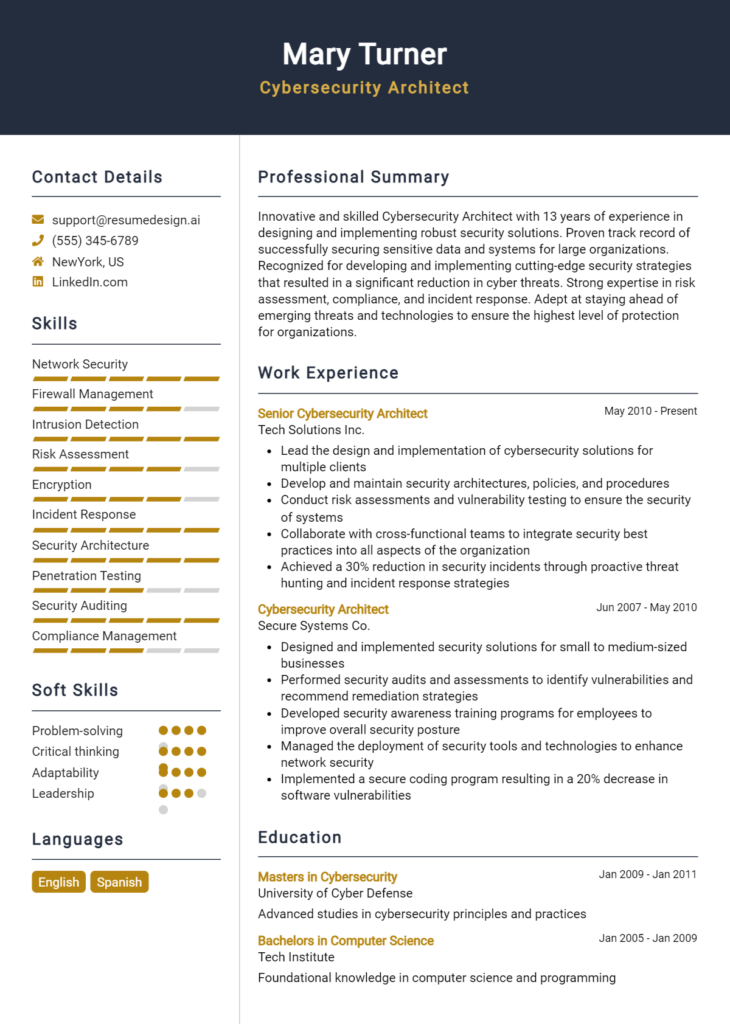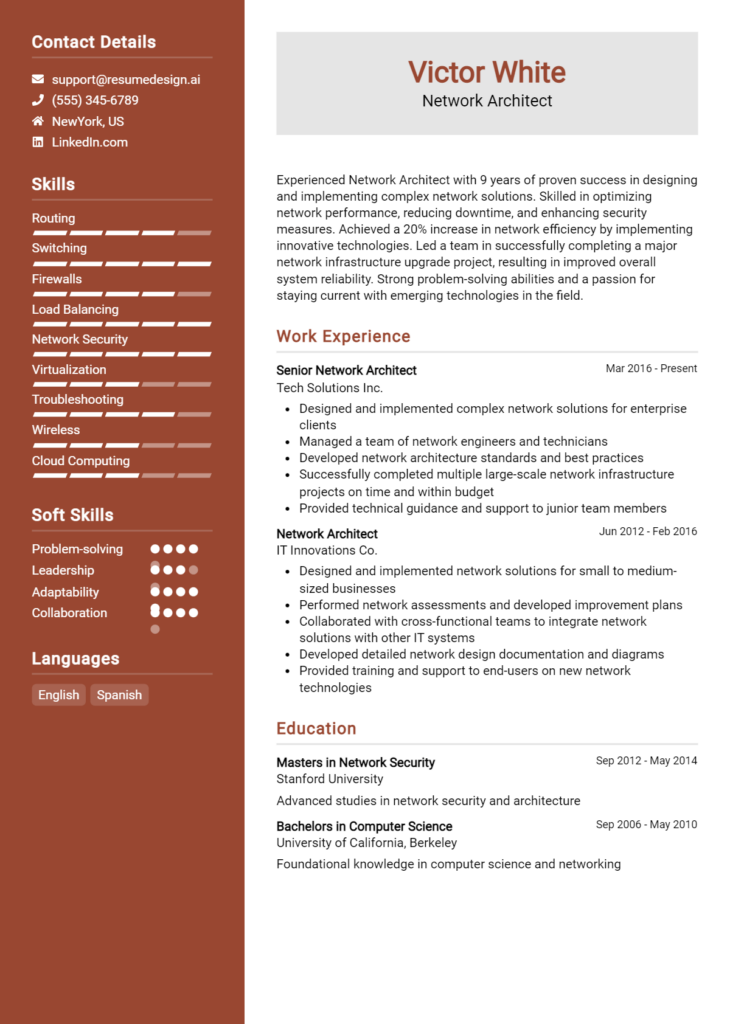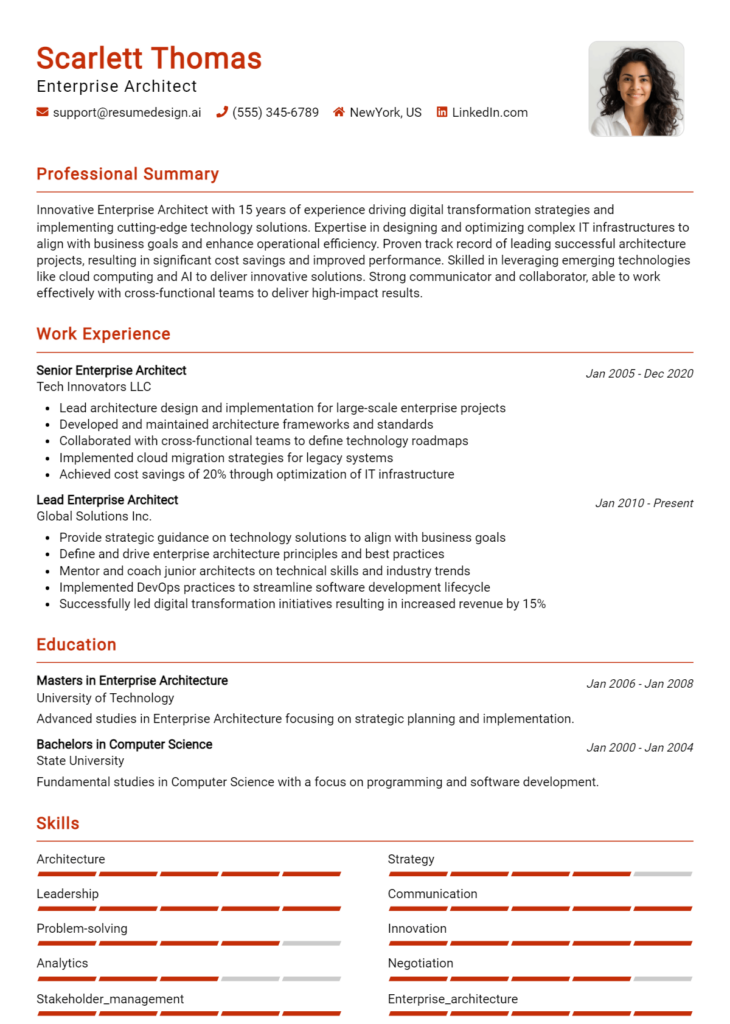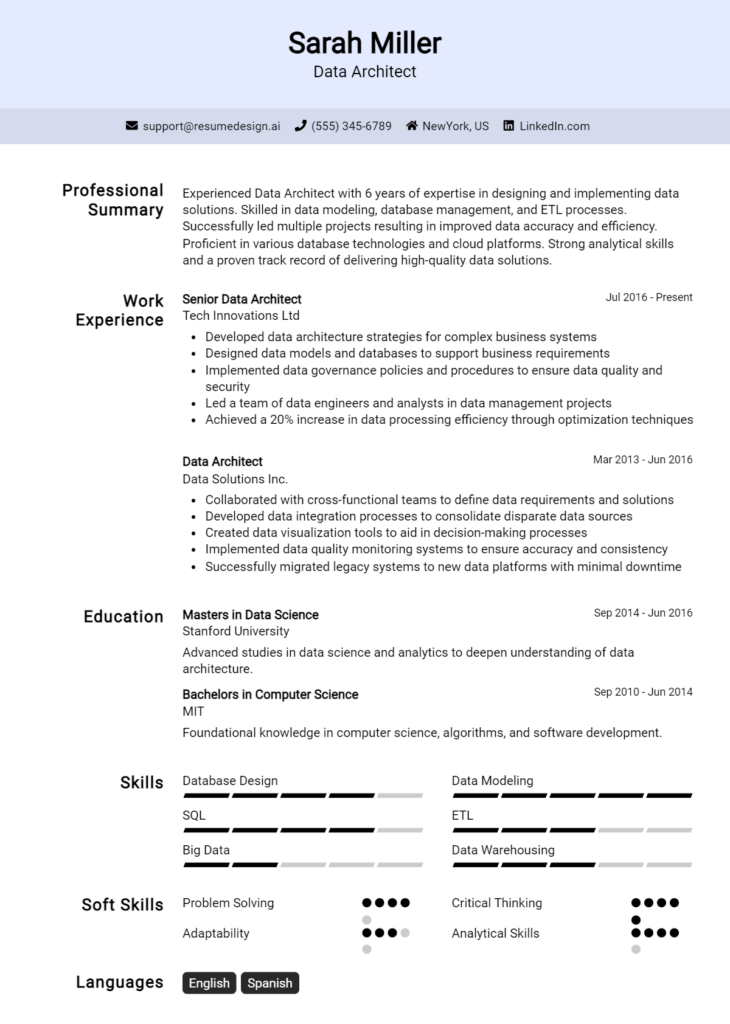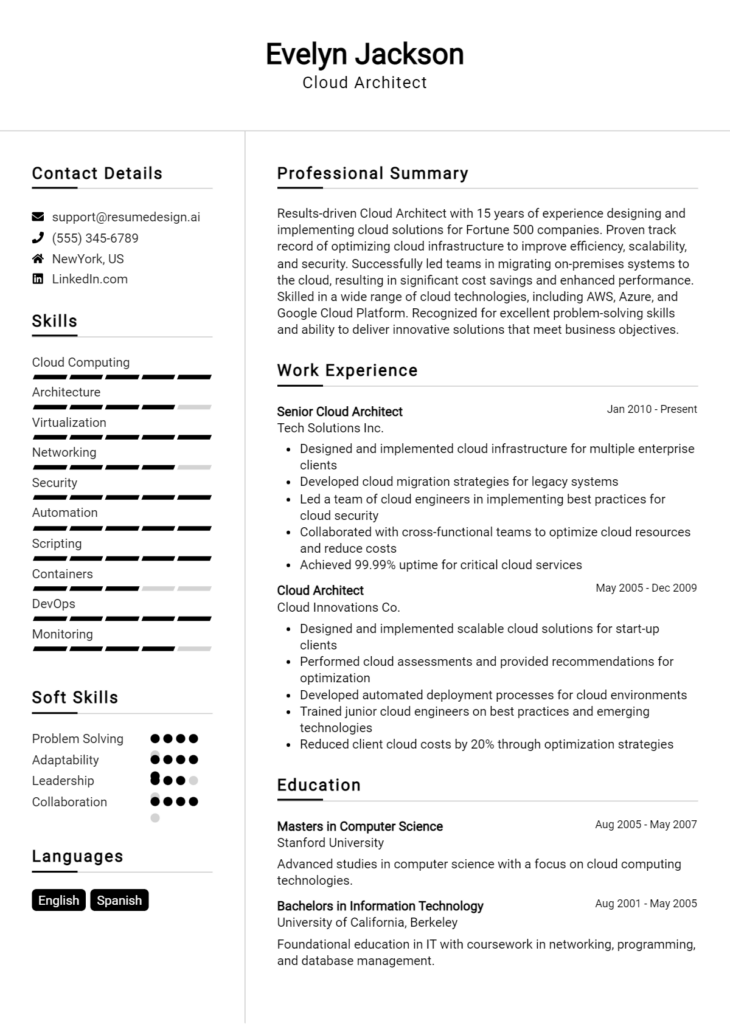Site Reliability Architect Core Responsibilities
A Site Reliability Architect plays a crucial role in ensuring the scalability, reliability, and performance of software systems. This professional bridges the gap between development and operations teams, leveraging technical expertise in cloud infrastructure, programming, and automation tools. Key responsibilities include incident management, system design, and optimizing performance. Strong problem-solving and analytical skills are essential to proactively address challenges, contributing to the organization's overall goals. A well-structured resume showcasing these abilities can significantly enhance career prospects.
Common Responsibilities Listed on Site Reliability Architect Resume
- Design and implement scalable and reliable infrastructure.
- Monitor system performance and troubleshoot issues proactively.
- Automate operational processes to enhance efficiency.
- Collaborate with development teams for seamless deployment.
- Establish incident response protocols and conduct post-mortems.
- Develop and maintain documentation for systems and processes.
- Evaluate and integrate new technologies to improve service delivery.
- Implement disaster recovery and business continuity plans.
- Conduct capacity planning and performance tuning.
- Ensure compliance with security protocols and best practices.
- Mentor team members and promote a culture of reliability.
- Participate in on-call rotations and incident response.
High-Level Resume Tips for Site Reliability Architect Professionals
In the competitive landscape of technology and engineering, a well-crafted resume is a critical tool for Site Reliability Architect professionals. It often serves as the first impression a candidate makes on potential employers, making it essential that the resume effectively showcases both skills and achievements. A strong resume not only highlights technical expertise but also reflects the unique contributions that a candidate can bring to an organization. This guide will provide practical and actionable resume tips specifically tailored for Site Reliability Architect professionals, helping you stand out in a crowded field.
Top Resume Tips for Site Reliability Architect Professionals
- Tailor your resume to match the job description, using keywords and phrases that align with the specific requirements of the position.
- Showcase relevant experience by detailing past roles and responsibilities that directly relate to site reliability and infrastructure management.
- Quantify your achievements with metrics, such as uptime percentages, incident response times, or cost savings realized through process improvements.
- Highlight industry-specific skills, including proficiency in cloud platforms, monitoring tools, and automation frameworks that are critical for site reliability.
- Include a summary statement at the top of your resume that encapsulates your career goals and expertise in site reliability architecture.
- Demonstrate teamwork and collaboration by mentioning experiences working with cross-functional teams to enhance system performance and reliability.
- Incorporate relevant certifications such as Google Cloud Professional DevOps Engineer or AWS Certified Solutions Architect to validate your expertise.
- Keep your formatting clean and professional, ensuring that your resume is easy to read and visually appealing to attract attention.
- Use action verbs to describe your responsibilities and achievements, making your contributions more impactful and dynamic.
- Regularly update your resume to reflect new skills, projects, and accomplishments, ensuring that it remains current and relevant.
By implementing these tips, Site Reliability Architect professionals can significantly increase their chances of landing a job in a dynamic and demanding field. A resume that effectively showcases relevant skills, quantifiable achievements, and tailored content will resonate with hiring managers, setting you apart from the competition and paving the way for exciting career opportunities.
Why Resume Headlines & Titles are Important for Site Reliability Architect
In the competitive field of Site Reliability Engineering, a well-crafted resume headline or title plays a pivotal role in grabbing the attention of hiring managers. A strong headline serves as a powerful introduction, summarizing a candidate’s key qualifications and expertise in a concise and impactful phrase. It sets the tone for the entire resume, providing a clear indication of the candidate's professional identity and value proposition. A compelling headline should be relevant to the position being applied for, ensuring that it reflects the specific skills and experiences that align with the job requirements, ultimately increasing the chances of making a memorable first impression.
Best Practices for Crafting Resume Headlines for Site Reliability Architect
- Keep it concise—aim for one impactful phrase.
- Use role-specific keywords related to Site Reliability Engineering.
- Highlight your most relevant skills or certifications.
- Include measurable achievements when possible.
- Avoid jargon and overly technical language; clarity is key.
- Tailor the headline for each specific job application.
- Make sure it reflects your professional brand and career goals.
- Use action verbs to convey a sense of proactivity and impact.
Example Resume Headlines for Site Reliability Architect
Strong Resume Headlines
"Experienced Site Reliability Architect with Proven Expertise in Cloud Infrastructure and Automation"
"Site Reliability Engineer Specializing in High-Availability Systems and Performance Optimization"
"Certified Site Reliability Architect with 10+ Years of Experience in DevOps and System Resilience"
"Innovative SRE Professional Focused on Scaling Distributed Systems and Enhancing User Experience"
Weak Resume Headlines
“Site Reliability Architect Looking for Opportunities”
“IT Professional with Various Skills”
The strong headlines are effective because they are specific, highlighting relevant skills or experiences that align with the Site Reliability Architect role. They clearly communicate the candidate's value and expertise, making it easy for hiring managers to understand their qualifications at a glance. In contrast, the weak headlines lack detail and fail to convey any meaningful information about the candidate’s strengths or suitability for the position. This vagueness makes it difficult for hiring managers to see the candidate's potential contribution to their organization, resulting in missed opportunities.
Writing an Exceptional Site Reliability Architect Resume Summary
Crafting an exceptional resume summary is crucial for a Site Reliability Architect, as it serves as the first impression for hiring managers. A well-written summary quickly captures attention by highlighting key skills, relevant experience, and notable accomplishments that align with the demands of the role. It should be concise and impactful, offering a snapshot of the candidate's qualifications while being tailored to the specific job they are applying for. A strong summary not only showcases what the candidate brings to the table but also sets the tone for the rest of the resume.
Best Practices for Writing a Site Reliability Architect Resume Summary
- Quantify Achievements: Use specific metrics to demonstrate the impact of your work, such as uptime percentages or cost savings.
- Focus on Relevant Skills: Highlight technical skills and tools that are directly applicable to the Site Reliability Architect role.
- Tailor for the Job Description: Customize your summary to reflect the specific requirements and responsibilities listed in the job posting.
- Be Concise: Keep your summary to 3-5 sentences that effectively capture your professional identity.
- Use Action-Oriented Language: Start with strong verbs to convey your accomplishments and responsibilities dynamically.
- Showcase Soft Skills: Include soft skills relevant to collaboration, problem-solving, and communication that are vital in a reliability-focused role.
- Highlight Certifications: Mention any relevant certifications or advanced degrees that enhance your credibility as a Site Reliability Architect.
- Emphasize Continuous Improvement: Reflect an ongoing commitment to learning and adapting in the fast-paced tech environment.
Example Site Reliability Architect Resume Summaries
Strong Resume Summaries
Results-driven Site Reliability Architect with over 7 years of experience in optimizing cloud infrastructure, achieving a 99.99% uptime for critical services while reducing operational costs by 30%. Expert in Kubernetes, Terraform, and CI/CD pipelines.
Dedicated SRE professional with a proven track record of implementing automation solutions that improved deployment efficiency by 40% and reduced incident response time by 50%. Skilled in monitoring tools like Prometheus and Grafana.
Innovative Site Reliability Architect with extensive experience in designing resilient systems, leading to a 20% decrease in downtime incidents. Proficient in Python and Go, with a focus on performance tuning and system scalability.
Weak Resume Summaries
Site Reliability Architect with several years of experience in IT. Looking for opportunities to improve systems and work on interesting projects.
Motivated individual skilled in various technologies. Experienced in working in teams and managing projects in the tech industry.
The strong resume summaries stand out because they include specific metrics and relevant skills that directly relate to the Site Reliability Architect role. They demonstrate quantifiable results and showcase the candidate's ability to contribute effectively. In contrast, the weak summaries lack detail and specificity, making them too vague and generic to capture a hiring manager's interest. They do not provide any measurable outcomes or particular skills that would set the candidate apart from others.
Work Experience Section for Site Reliability Architect Resume
The work experience section of a Site Reliability Architect resume is crucial as it serves as a testament to the candidate's technical prowess and managerial capabilities. This section not only highlights the applicant's ability to manage complex systems and ensure reliability but also showcases their experience in leading teams and delivering high-quality products. By quantifying achievements, such as performance improvements or cost reductions, candidates can effectively demonstrate their impact. Aligning their experience with industry standards further strengthens their position, making it clear that they are equipped to handle the demands of this evolving role.
Best Practices for Site Reliability Architect Work Experience
- Clearly outline your technical expertise in relevant tools and technologies used in site reliability.
- Quantify your achievements with specific metrics, such as uptime percentages or response times improved.
- Highlight leadership roles and team management experiences to showcase your ability to guide projects successfully.
- Include collaborative efforts with cross-functional teams to illustrate your teamwork skills.
- Use industry-standard terminology and frameworks to align your experience with current best practices.
- Focus on problem-solving instances where your actions led to significant improvements.
- Tailor your experiences to match the requirements of the job you are applying for.
- Keep the descriptions concise, yet impactful, to maintain the reader's attention.
Example Work Experiences for Site Reliability Architect
Strong Experiences
- Led a cross-functional team to implement a new monitoring system, resulting in a 30% reduction in incident response time and enhancing system reliability.
- Architected and deployed a container orchestration solution that improved resource utilization by 25%, significantly cutting operational costs.
- Developed and executed a disaster recovery plan that achieved 99.9% uptime during a major infrastructure upgrade, ensuring business continuity.
- Collaborated with software development teams to automate deployment processes, reducing deployment times by 50% and increasing deployment frequency.
Weak Experiences
- Worked on various projects related to site reliability.
- Helped improve system performance.
- Participated in team meetings and discussions.
- Contributed to the overall success of the IT department.
The examples classified as strong experiences effectively communicate specific achievements, quantifiable metrics, and leadership roles, showcasing the candidate's impact on their previous organizations. In contrast, the weak experiences lack detail and specificity, failing to provide a clear picture of the candidate's contributions or skills. Strong experiences resonate with potential employers by demonstrating not only what was accomplished but also the direct benefits those accomplishments provided, while weak experiences leave much to be desired in terms of clarity and substance.
Education and Certifications Section for Site Reliability Architect Resume
The education and certifications section of a Site Reliability Architect resume is crucial in establishing a candidate's qualifications and expertise in the field. This section not only highlights the candidate's academic background but also showcases industry-relevant certifications and their commitment to continuous learning. By providing details on relevant coursework, certifications, and any specialized training, candidates can significantly enhance their credibility and demonstrate alignment with the specific requirements of the Site Reliability Architect role. In a competitive job market, showcasing this information effectively can make a substantial difference in the hiring decision.
Best Practices for Site Reliability Architect Education and Certifications
- Prioritize relevant degrees, such as Computer Science, Information Technology, or Engineering.
- Include industry-recognized certifications like Google Professional Cloud Architect, AWS Certified Solutions Architect, or Kubernetes Administrator.
- Highlight specialized training or workshops attended that relate to site reliability engineering or DevOps practices.
- Be specific about relevant coursework, particularly in systems design, cloud computing, and infrastructure management.
- Showcase any continuous learning efforts, such as online courses or training programs that enhance skills pertinent to site reliability.
- Tailor the education and certifications section to match the job description requirements, emphasizing the most relevant qualifications.
- List certifications in reverse chronological order to emphasize the most recent and relevant qualifications.
- Avoid including irrelevant degrees or certifications that do not add value to the Site Reliability Architect role.
Example Education and Certifications for Site Reliability Architect
Strong Examples
- Bachelor of Science in Computer Science, XYZ University
- AWS Certified Solutions Architect – Professional
- Google Professional Cloud Architect Certification
- Coursework: Advanced Networking, Distributed Systems, and Cloud Infrastructure Management
Weak Examples
- Associate Degree in Graphic Design
- Microsoft Office Specialist Certification
- Certificate in Basic HTML and CSS
- Coursework: Art History and English Literature
The examples provided illustrate the distinction between strong and weak qualifications for a Site Reliability Architect role. Strong examples align directly with the technical and operational demands of the position, showcasing relevant degrees, advanced certifications, and specialized coursework that demonstrates expertise in site reliability engineering. In contrast, weak examples consist of qualifications that are either unrelated to the field or do not reflect the advanced skills and knowledge necessary for success in the role, thus diminishing the candidate’s appeal to potential employers.
Top Skills & Keywords for Site Reliability Architect Resume
The role of a Site Reliability Architect (SRA) is crucial in ensuring the reliability, availability, and performance of systems and services. Crafting a compelling resume for this position requires a keen focus on both hard and soft skills. These skills not only highlight your technical expertise but also demonstrate your ability to collaborate effectively, problem-solve, and lead teams in a fast-paced environment. A well-structured resume that showcases these skills can significantly enhance your chances of landing an interview, as employers seek candidates who can bridge the gap between development and operations while maintaining a focus on user experience and system performance.
Top Hard & Soft Skills for Site Reliability Architect
Soft Skills
- Excellent Communication
- Problem-Solving Abilities
- Team Collaboration
- Adaptability
- Critical Thinking
- Leadership
- Time Management
- Conflict Resolution
- Emotional Intelligence
- Customer-Centric Mindset
Hard Skills
- Cloud Computing (AWS, Azure, GCP)
- Containerization Technologies (Docker, Kubernetes)
- Infrastructure as Code (Terraform, Ansible)
- Monitoring and Logging Tools (Prometheus, Grafana, ELK Stack)
- Scripting Languages (Python, Bash, Go)
- Networking Concepts (TCP/IP, DNS, Load Balancing)
- Continuous Integration and Continuous Deployment (CI/CD)
- System Architecture Design
- Security Best Practices
- Database Management (SQL, NoSQL)
For further enhancement of your resume, consider exploring essential skills and comprehensive work experience sections that align with the demands of the Site Reliability Architect role.
Stand Out with a Winning Site Reliability Architect Cover Letter
Dear [Hiring Manager's Name],
I am writing to express my enthusiasm for the Site Reliability Architect position at [Company Name] as advertised on [where you found the job posting]. With over [X years] of experience in site reliability engineering and a proven track record of deploying scalable systems, I am confident in my ability to contribute to your team and help enhance the reliability and performance of your applications. My background in software development, combined with my expertise in cloud infrastructure and automation, positions me uniquely to bridge the gap between development and operations, ensuring a seamless delivery pipeline.
In my previous role at [Previous Company Name], I successfully led initiatives to improve system reliability by implementing robust monitoring solutions and developing automated recovery processes. By utilizing tools such as Prometheus, Grafana, and Kubernetes, I was able to reduce system downtime by [X%] and improve response times for user-reported issues. My collaborative approach allowed me to work closely with cross-functional teams, fostering a culture of shared responsibility for system performance and reliability. I believe that promoting a DevOps mindset is crucial for achieving operational excellence, and I am eager to bring this philosophy to [Company Name].
Furthermore, I hold a [relevant certification, e.g., AWS Certified Solutions Architect] and have experience with various cloud platforms, which has equipped me with the skills necessary to design and implement effective architectures that can support high availability and disaster recovery. I am particularly drawn to [Company Name] because of your commitment to innovation and excellence in technology. I am excited about the opportunity to work with a team that values continuous improvement and strives to provide a seamless experience for its users.
Thank you for considering my application. I am looking forward to the possibility of discussing how my skills and experiences align with the goals of [Company Name]. I am enthusiastic about the opportunity to contribute to your team and help drive the reliability and performance of your systems to new heights.
Sincerely,
[Your Name]
[Your Contact Information]
[LinkedIn Profile or Portfolio URL]
Common Mistakes to Avoid in a Site Reliability Architect Resume
When crafting a resume for a Site Reliability Architect position, it's crucial to present your skills and experience in a clear and compelling manner. However, many candidates make common mistakes that can undermine their chances of landing an interview. Understanding these pitfalls can help you create a resume that effectively showcases your qualifications and aligns with the expectations of potential employers in the tech industry.
Vague Job Descriptions: Failing to provide specific details about your previous roles can leave hiring managers puzzled. Clearly describe your contributions, technologies used, and the impact of your work.
Ignoring Relevant Skills: Omitting key skills that are essential for Site Reliability Engineering (SRE), such as cloud platforms, automation tools, and monitoring solutions, can make your resume less appealing. Ensure you highlight all relevant technical competencies.
Overly Technical Language: While it's important to demonstrate your technical expertise, using jargon or overly complex terms can alienate non-technical HR personnel. Aim for a balance that is accessible yet informative.
Lack of Metrics: Not including quantifiable achievements can weaken your resume. Use metrics to illustrate your impact, such as uptime improvements, cost reductions, or performance enhancements.
One-Size-Fits-All Approach: Sending out a generic resume without tailoring it to each job application can be detrimental. Customize your resume to align with the specific requirements and culture of the company you're applying to.
Ignoring Soft Skills: SRE roles often require strong collaboration and communication skills. Neglecting to mention these soft skills can give an incomplete picture of your capabilities as a Site Reliability Architect.
Poor Formatting: A cluttered or overly complicated layout can distract from your content. Use a clean, professional format that enhances readability and emphasizes key sections.
Failure to Include Continuous Learning: The tech landscape is ever-evolving, and not showcasing your commitment to continuous learning, such as certifications or courses, may signal stagnation. Highlight any ongoing education or professional development initiatives you are involved in.
Conclusion
As we explored the critical role of a Site Reliability Architect (SRA), it became evident that this position is fundamental in bridging the gap between development and operations. The SRA's responsibilities include designing scalable systems, automating processes, and ensuring high availability, all while maintaining a focus on performance and reliability.
Key skills identified for a successful SRA include proficiency in cloud technologies, a strong understanding of system architecture, and the ability to implement robust monitoring and incident response strategies. Furthermore, soft skills such as effective communication and teamwork are essential in collaborating with cross-functional teams to achieve organizational goals.
In conclusion, if you're looking to advance your career as a Site Reliability Architect, it's crucial to present a strong resume that highlights your expertise and accomplishments. Take the time to review your resume and ensure it effectively showcases your skills and experiences. To assist you in this process, consider utilizing resources like resume templates, the resume builder, resume examples, and cover letter templates available online. These tools can help you create a compelling and professional presentation of your qualifications, making you stand out in the competitive job market. Don’t delay—start refining your resume today!

